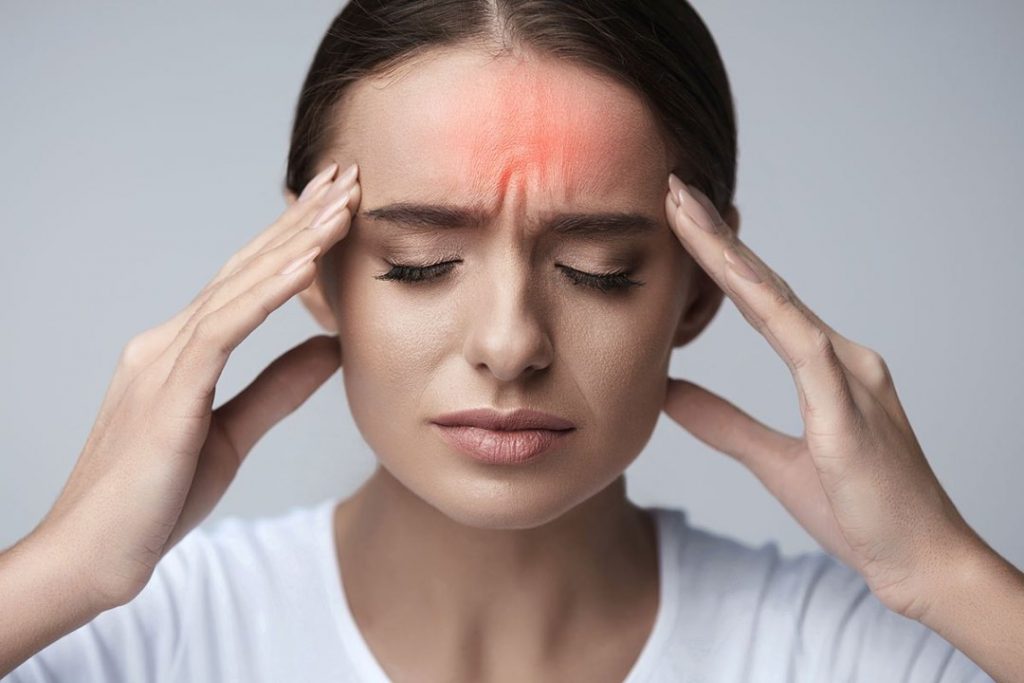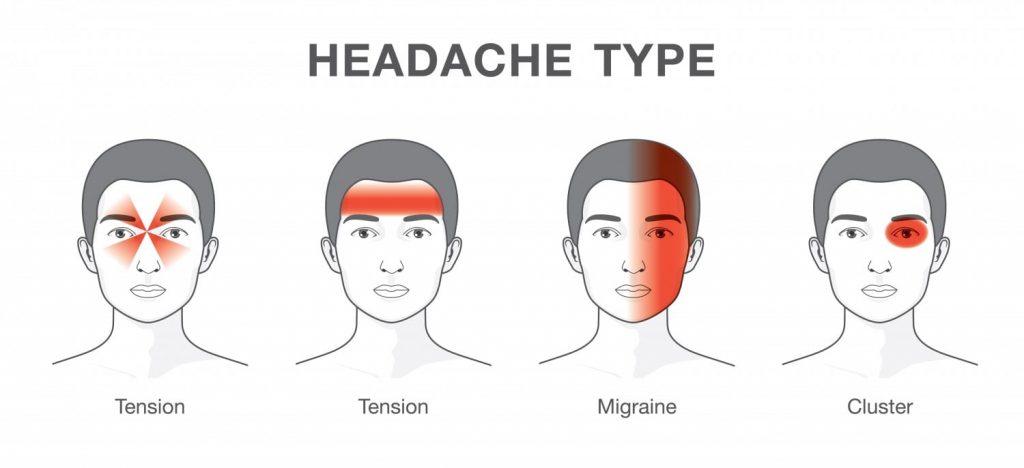Many people believe migraines are similar to general headaches. Well, it is not. Migraine is very different from a typical headache, since it is strong and accompanied by nauseous feeling and vomiting. Most people who experience it are also sensitive to light.[1]
While a normal headache is short-lived, migraine is not. The condition is different for everyone and can last from hours to days.[2]

The Top Symptoms
Due to a lack of knowledge regarding the stages of a migraine, people do not start the treatment early. It is for this reason that people have a lot of problems. The stages of migraine are
Prodrome
This is the initial stage of your migraine. Before the actual attack, most people suffer from symptoms of the prodrome stage.[3] These symptoms include
- Increased thirst
- Bloating
- Fatigue
- Light sensitivity
- Lack of appetite or increased hunger
- Mood fluctuations
Aura
Aura initially begins in the nervous system and then goes on to attack the vision. It is an extremely irritating state that can last from 5-20 minutes. Sometimes, the pain may even last for more than an hour. Common feelings during aura include
- Inability to speak
- Tunnel vision
- Seeing black dots
- Ringing in ears
- Change in sensation
- Numb or tingling body
Attack
Migraine may start as a dull pain and will eventually grow into a serious one. It’s often more severe if you are into any physical activity.[4]
The pain arises in one side of the head and will eventually move to another, eventually affecting the entire head. Most people start feeling nauseous and feel as if they would vomit. Sometimes, it may also lead to pale or clammy feelings.[5]
If the headache is too severe, it can last for more than 4 hours or even more than three days. People suffering from migraines go through the attack at least two to four times a month. While many people experience migraine attacks in a few days, some may experience it once or twice each year.
Postdrome
The final stage of a headache may include the following symptoms.
- Feeling tired
- Not staying happy or refreshed
- Muscle pain
- Increased hunger or lack of appetite
The Top Causes of Migraine
The exact cause remains unknown, but doctors believe most of the causes are related to either your brain or gene. There is a higher likelihood of you suffering from migraines should your parents experience it too. Other triggers include bright light, weather change and fatigue.[6]
Scientists have often suggested the change in blood flow to be one of the most prominent causes.
A migraine attack sends triggers down the trigeminal nerves that can affect your face and head. Your body then releases chemicals such as serotonin and calcitonin gene-related peptide. The neurotransmitters are the main reason for pain and inflammation.[7]

The Top Risk factors
Millions of people around the world are affected by migraines. While many think that older people are likely to be affected by migraine, it is not so. Younger people can experience migraines too.[8]
If you are experiencing a migraine attack, you will need to refrain from certain activities.
Here is a look at some of the top factors that can lead to the condition.
- Sex: Women tend to suffer three times more than men.
- Family history: If you have a family history, you are likely to have it too. If either of the parents has migraines, the child has a 50% risk of developing it too.
- Age: People start experiencing migraine pain from the age of 10-40 years, which eventually vanishes after the age of 50.
- Medical conditions: Certain medical conditions such as sleep disorders, depression, epilepsy and anxiety can make you prone to migraines.[9]
Migraine Triggers
Some of the worst yet common triggers include the following
- Hormonal changes
- Stress
- Caffeine
- Senses
- Weather changes
- Medications
- Tobacco
- Changes in sleep schedule
Migraine Diagnosis
If you have been experiencing migraine attacks frequently, your doctor will examine you and want to know about your family history. You are bound to notice the triggers and symptoms that need to be addressed immediately – these can help in making treatment easy.[10]
Here are some questions you need to ask yourself.
- How long does your pain last?
- Do you have a family history of migraine?
- Does your medicine trigger the attack?
- What are the symptoms?
The doctor will conduct blood tests, CT scans or MRIs to check the condition.[11]
Treatment and Home Remedies
There is no full-proof treatment, but certain home remedies can help to ease the pain.
Pain Relief
You may want to take over-the-counter medicines such as caffeine, ibuprofen and aspirin to ease the pain. However, aspirin shouldn’t be consumed by people below the age of 19years because it increases the risk of Reye’s syndrome.[12]
Nausea medicine
If you feel nauseous, the doctor will recommend medicine to treat the condition.
CGRP receptor antagonists
If the above-mentioned treatments do not cure the condition, the doctor will recommend rimegepant and ubrogepant.
Here are some of the small lifestyle changes you can make to feel better.
- Rest in a dark and quiet room
- Apply a cold compress on your forehead
- Drink a lot of water
Migraine can be difficult to control if you aren’t careful. Often, the condition may seem to persist down the years, but you can definitely have it withing control so that you can live a normal healthy life. Consult your doctor if you experience severe symptoms.[13]
[1] https://www.ncbi.nlm.nih.gov/pmc/articles/PMC4416971/
[2] https://www.ncbi.nlm.nih.gov/books/NBK554611/
[3] Fraser CL, Hepschke JL, Jenkins B, Prasad S. Migraine Aura: Pathophysiology, Mimics, and Treatment Options. Semin Neurol. 2019 Dec;39(6):739-748. [PubMed]
[4] Marmura MJ. Triggers, Protectors, and Predictors in Episodic Migraine. Curr Pain Headache Rep. 2018 Oct 05;22(12):81. [PubMed]
[5] https://www.ncbi.nlm.nih.gov/pmc/articles/PMC5587613/
[6] Vetvik KG, MacGregor EA. Sex differences in the epidemiology, clinical features, and pathophysiology of migraine. Lancet Neurol. 2017 Jan;16(1):76-87. [PubMed]
[7] https://www.ncbi.nlm.nih.gov/pmc/articles/PMC4412887/
[8] Iyengar S, Johnson KW, Ossipov MH, Aurora SK. CGRP and the Trigeminal System in Migraine. Headache. 2019 May;59(5):659-681. [PMC free article] [PubMed]
[9] https://www.ncbi.nlm.nih.gov/books/NBK279373/
[10] Deen M, Christensen CE, Hougaard A, Hansen HD, Knudsen GM, Ashina M. Serotonergic mechanisms in the migraine brain – a systematic review. Cephalalgia. 2017 Mar;37(3):251-264. [PubMed]
[11] Yuan H, Lauritsen CG, Kaiser EA, Silberstein SD. CGRP Monoclonal Antibodies for Migraine: Rationale and Progress. BioDrugs. 2017 Dec;31(6):487-501. [PubMed]
[12] https://www.ncbi.nlm.nih.gov/books/NBK544087/
[13] Gasparini CF, Smith RA, Griffiths LR. Genetic and biochemical changes of the serotonergic system in migraine pathobiology. J Headache Pain. 2017 Dec;18(1):20. [PMC free article] [PubMed]

